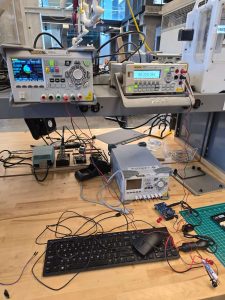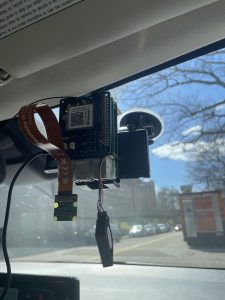Personal Accomplishments
Final Demo and Video: Worked together on writing final presentation poster, block diagrams, and final video script
Progress
My progress is on schedule.
Schedule
Final video, report, and demo prepare

Crowdsourced Automatic License Plate Recognition (ALPR) Network – Christine Li, Vicky Liu, Andy Zhao
Personal Accomplishments
Final Demo and Video: Worked together on writing final presentation poster, block diagrams, and final video script
Progress
My progress is on schedule.
Schedule
Final video, report, and demo prepare
Learning Reflections
As I progressed through the design, implementation, and debugging phases of our project, I encountered several hardware components that required me to acquire new technical knowledge and hands-on skills for the bring up of them. Specifically, I faced challenges in bringing up the Raspberry Pi (RPi) system, the RPi camera module, the uninterruptible power supply (UPS) module, and the Blues Notecard module.
To overcome these challenges, I adopted a multi-pronged learning strategy:
Summary of Work This Week:
This week is mainly integration testing and final wrap-up and final documentation preparation. I did the power adapter system integration testing in-vehicle. I measured output voltage and current of the adapter during driving conditions to verify power stability and confirmed that the UPS output to the Raspberry Pi 5 consistently delivered the required 5V 5A, ensuring reliable operation.
At the same time, I worked together with my teammates on assembling slides and visuals for the final presentation and began preparing talking points and demo setup for the final showcase.
Progress:
We are currently on progress, we finished most system integration testing, and are ready to prepare for final demo and documentation preparation.
Next Steps and Schedule:
• Record final demo footage and supporting visuals for the video presentation.
• Deliver final presentation and participate in demo day.
We are currently on track

Verification and Validation Update:
As we transition into the verification and validation phase, we are aligning our testing approach with our core engineering design and use case requirements. I am mainly in charge of the dashcam circuit components so my individual testing are more oriented with the dash cam power supply system.
Our dashcam power system is designed to draw power from the car’s cigarette lighter, which is converted by an adaptor to 8.4V 2A for the UPS(Uninteruptable Power Supply). The UPS then regulates this input to provide a stable 5V 5A output to the Raspberry Pi, while also managing seamless switching to its internal battery when the car is turned off—ensuring a safe shutdown process for the RPi.
Tests Completed:
After verified the system works during simulation test in the lab, I tested the system on a car with actual car cigarette lighter.
Verification Approach:
Planned Tests:
Summary of Work This Week:

Next Steps and Schedule:
Progress:
This week, I made progress by completing the majority of the circuit-level testing. I verified the power regulation behavior of our adaptor and UPS module, both in simulation and in a real vehicle environment. With these components confirmed to be working, we are ready to move forward with full system integration using the car cigarette lighter as the actual power source.
Additional tests, including endurance and thermal testing, are planned to further ensure reliability under extended and realistic conditions.


This week, I successfully tested and brought up the uninterruptible power supply (UPS) module. Activities included setup, initial testing, installation, and integration with the Raspberry Pi 5 (RPI5).
Initially, powering via cable was unsuccessful due to lower-than-expected voltage, so I instead installed and powered the module directly through the RPI pins.
I brought up the UPS module connected to the RPI, wrote a script to detect battery charging and discharging states through if the direction of current flow, and modified this script to safely initiate an RPI shutdown sequence when power from the car is disconnected. This is very important for our project because we want to protect the board and the storage card for our system but the power supply from car shuts off right when the car is turned off by the driver. I also tested the script and if the safe RPI shutdown process was executted correctly when the power supply to the UPS is off.
Additionally, I reviewed the UPS documentation to investigate if automated restart of the RPI could be achieved when power returns. Currently, the UPS module lacks direct support for this function.
Next week, I plan to explore alternative solutions to automate restarting the system and eliminate the need for manually toggling the UPS module. Also next week I plan to test the safety and stability of the car cigarette lighter-to-UPS power supply adapter.
Progress:
Overall, progress is on track. I integrated together with Vicky on rpi modules and they are currently working. All team members conducted a initial road testing with our dash cam system to test the end-to-end functionality. We currently used a portable power supply for the power supply source for the UPS module before we could safely use the car cig-lighter power supply adaptor. The end-to-end system tested to be working as we could receive API calls on our AWS server from our dash cam.
Schedule:
This week, I focused on the bring-up of the Blues module with the Raspberry Pi 5, as well as the setup and testing of the Blues Notehub system.
After successfully initializing the Blues Notecard chip on the Raspberry Pi 4, I migrated the setup to the Raspberry Pi 5. The migration was successful, and the chip was fully set up and operational on the new platform.
In parallel, I configured Blues Notehub, which serves as the cloud interface to receive and process requests sent from the Blues Notecard chip. I verified successful communication between the chip and Notehub by sending and receiving test requests.
Additionally, I collaborated with my team to integrate the request-sending flow. We successfully sent requests using a demo URL, confirming the proper functionality of the system pipeline. We also worked together to connect and send requests to our central server via the AWS API. While the request was sent, we encountered some errors during the process, which we plan to debug and resolve in the upcoming week.
Progress:
Overall, progress is on track after I have shifted my focus from the web app to assisting Vicky and Christine with dashcam and server implementation. We are having a little issue with integrating the Blues LTE service with communicating with the AWS server, but we believe we could fix this on time.
Schedule:
his week, I focused on planning power testing, discussing the web application, and beginning the Blues module bring-up by testing it on the RPi4.
To ensure a stable power supply for the RPi5, I developed a power testing plan. I researched various Uninterruptible Power Supply (UPS) HATs compatible with the RPi5 and placed an order. While waiting for delivery, I started planning the circuit testing process to ensure the module functions correctly and continues supplying power even when its main power source is turned off.
On the software side, I discussed with my team and Tamal the idea of not implementing a web portal but instead opting for a flexible and easier-to-implement API for user interaction.
Additionally, I began bringing up the Blues module, starting with initial tests on the RPi4 to verify communication and connectivity. I booted up the RPi4 and started integrating the Blues cellular chip with it.
Progress:
Overall, progress is on track. I have shifted my focus from the web app to assisting Vicky and Christine with dashcam and server implementation.
Schedule:
•Test the UPS module (if it arrives)
•Bring up the Blues module and test GPS
•Test uploading and receiving data from the server using the Blues chip on the RPi
This week, I focused on solving the dash cam circuit issue, worked on rpi5 and camera module bring up, started web app backend implementation, and worked on the design report.
Since the RPi5 must shut down gracefully when the car’s engine is turned off, ensuring a stable interim power supply is crucial. I compared several available modules based on output voltage, run-time capacity, size constraints, and ease of integration, with the goal of finding a solution that meets both our technical and cost requirements.
I collaborated with Vicky to bring up the RPi5 and Camera Module 3, verifying that the drivers and interfaces worked correctly on our target hardware. We tested that the camera is working by taking test images to see if it meets the resolution. And we started thinking how to implement the loop recording and ALPR calling function on the rpi camera.
On the software side, I began implementing the backend for our web application.
Lastly, I spent time writing and refining our design report.
Progress:
overall the progress is on time, but the web app backend implementation could go a little faster as there are still many functionality not implemented yet. But luckly next week is the spring break and I plan to make some progress during the week. But overall, I am on progress
Schedule:

A was written by Andy, B was written by Vicky, and C was written by Christine.